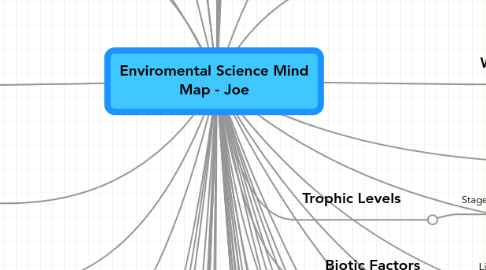
1. Population
1.1. Same type of animals living in a given area.
1.1.1. Bears
1.1.2. Tigers
1.1.3. Kangaroos
1.1.4. Trout
2. Ecosystem
2.1. Several communities interacting with their enviorment
2.1.1. Community 1 (Bears and Trout) - Temperate Deciguous Forests
2.1.2. Community 2 (Fox and wild birds) - Temperate Deciguous Forests
3. Biomes
3.1. Many ecosystems in one, with a specific climate.
3.1.1. Desert
3.1.2. Ocean
3.1.3. Tundra
3.1.4. Deciguous and Coniferous forests
3.1.5. Rainforest
3.1.6. Savannah
4. Rainforest
4.1. A biome that has a specific climate (humid and alot of percipitation) and destinctive orgranisms.
4.1.1. Rain
4.1.2. Humid
4.1.3. Tucan
4.1.4. Lizards
4.1.5. Monkeys
5. Temperate Deciguous forest
5.1. A biome of trees with leaves
6. Coniferous forest
6.1. A biome of trees with needles (pine needles etc.)
7. Desert
7.1. A biome with a hot, humid climate and destinctive organisms.
7.1.1. Scorpions
7.1.2. Cacti
8. Tundra
8.1. A very cold climate. Most of the time snow is involved.
8.1.1. Snow
8.1.2. Glaciers
9. Freshwater Biome
9.1. A biome of non-salt (fresh) water and destinctive species to that water conditions.
9.1.1. Fish
9.1.2. Plants
10. Marine Biome
10.1. A biome of salt water and destinctive oganisms that can live in that water conditions.
10.1.1. Crabs
10.1.2. Fish like Tuna etc.
11. Grassland/Savannah
11.1. A usually dry area with mostly grassland.
11.1.1. Rabbits
11.1.2. Birds
12. Food Chain
12.1. A chain of species being eaten by its predaor and then its predator, etc. until the largest animal with no predators
13. Food Web
13.1. A number of species in a "web" that shows more then one predator per species most of the time. Also it usually shows a predators mutiple preys.
14. Producer
14.1. First organism on a food chain or web and it is a plant that transfers energy to a consumer.
14.1.1. Any type of plant
15. Primary Consumer
15.1. The first degree of a consumer that usually feeds of the Producer.
15.1.1. Mice
16. Secondary Consumer
16.1. The second degree of a consumer typically shown in a food chain or web, it usually feeds on the Primary Consumer.
16.1.1. Hawk
17. Tertiary Consumer
17.1. The third degree of a consumer typically shown in a food chain or web, it usually feeds on the Secondary Consumer.
17.1.1. Larger bird of prey, Ex: Eagle
18. Decomposer
18.1. Bacteria of organisms that break down/eat dead orgranisms
18.1.1. Bacteria
18.1.2. Worms
19. Point Source
19.1. Pollution that comes from a traceable source.
20. Organic Pollutant
20.1. Something that is organic but has pollutants in it.
21. Inorganic Pollutant
21.1. Things like fertilizers and other man made products that pollute.
22. Organism
22.1. A living entity.
22.1.1. Examples
22.1.1.1. Bear
22.1.1.2. Grasshopper
22.1.1.3. Algae
22.1.1.4. Fungi
22.1.1.5. Sunflower
22.1.1.6. Kangaroo
23. Community
23.1. Several populations interacting in a given area.
23.1.1. Bears and Trout
23.1.2. Tigers and Lions
23.1.3. Fox and Wild Birds
